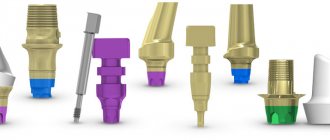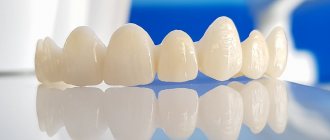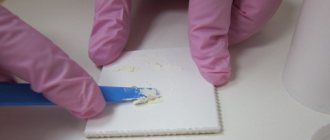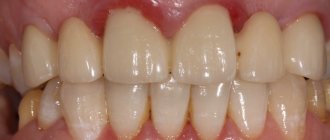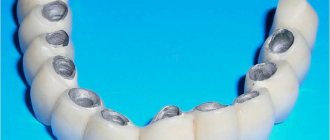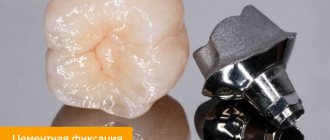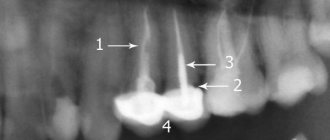Dental clinic "Smile Line" installs different types of crowns on implants at affordable prices.
If you need to restore the integrity of your teeth and restore the beauty of your smile, make an appointment with our doctors. We use the latest equipment and high-quality safe materials in our work. This allows us to achieve excellent therapeutic results even in advanced cases. You can find out how much implantation treatment costs by reading the price list or asking the operator a question by phone.
Types of crowns for implants
What kind of crowns are placed on implants? Like regular dentures, implant-supported dental crowns come in a variety of types depending on the material. Today, the most popular materials used in the manufacture of crowns on implants are ceramics and metal-ceramics. Their main difference, as the name suggests, is the presence or absence of a metal frame in the design. Recently, it has become popular, for example, to install zirconium crowns on implants - all-zirconium or ceramic restoration structures made on a zirconium frame.
- Ceramic
Dentures made of ceramics are usually recommended to be installed in the area of the front teeth. Such structures are highly biocompatible, which means they do not have any negative effects on the soft tissues of the oral cavity. Plus, they look exactly like natural teeth. Ceramic crowns are more transparent, so in this case an abutment will be made of ceramic or zirconium. - Zirconium
Implant Crowns made from this modern material are most in demand by specialists today. The secret of their popularity is simple: they combine good aesthetic qualities and high strength. - Metal-ceramic
Metal-ceramic is perhaps the most common material used for the manufacture of dentures. Metal-ceramic crowns on implants for chewing teeth are inexpensive and reliable. They usually require a metal abutment.
What is an implant
Implants are titanium roots that are implanted into the bone tissue of the jaw. An artificial crown is attached on top of them, which is visually indistinguishable from a natural tooth. The metal root takes on all the functions of the removed unit, avoids gum atrophy, maintains diction, and ensures uniform load while chewing solid food.
The structure installed on the implant consists of three parts:
- a metal base implanted into the bone tissue of the jaw in place of the missing unit;
- abutment - intermediate link, periosteal element;
- dental crown.
Since there is an abutment between the prosthesis and the pin, the crown is most often made from one material, that is, the use of a metal frame is not necessary here.
What is the best crown to put on an implant?
The answer to this question depends on the area being implanted and your budget. If we are talking about chewing teeth and the patient does not want to overpay, then the doctor will most likely recommend metal ceramics. Zirconium crowns for chewing teeth will undoubtedly be the best option. However, it is also more expensive. If prosthetics takes place in the so-called smile zone, then it is better to place a crown on a ceramic implant. She will look not only beautiful, but also absolutely natural.
How are prostheses made and installed?
Modern technologies are closely intertwined with dentistry and have given it the following opportunities:
- instead of conventional impressions, digital scanning of the oral cavity is carried out using intraoral 3D scanners, and the data is immediately sent to a computer - to a specialized program for creating a model of the prosthesis,
- modeling a perfect smile even at the stage of preparation for implantation (for example, using the Digital Smile Design concept),
- milling of prosthetic bases on high-precision machines: allows you to create a perfectly adjacent structure - both to the abutment and to the opposite teeth when the jaws are closed.
If we consider the installation in a simplified version, then after fixing the abutments, impressions are taken, then a model is created in the laboratory - and a prosthesis is already made on its basis. Then it is tried on, and if the doctor and the patient are satisfied with everything, then the structure is permanently attached (with screws or cement).
Installing a crown on an implant
Installing a crown on an implant involves putting a specially machined crown on an abutment that connects it to the implant - an artificial root, while crowns for traditional prosthetics are made from casts of ground natural teeth and installed on previously prepared teeth.
How long does it take to place crowns on implants? It all depends on the clinical picture. If immediately after installation the implant is stable and there are no indications for delayed prosthetics, then the implantologist places a crown on the implant immediately. In the area of the chewing teeth, which are not visible when smiling, most likely, a crown will be placed several months after the final implantation.
Installation steps
- After installation, an abutment is placed on the dental implant. Essentially, it replaces the tooth stump that is left after preparing the tooth before installing a conventional crown.
- When the abutment is installed, the doctor takes an impression to subsequently make a permanent crown for the implant.
- The final stage of installing a dental crown on an implant is fixing the prosthesis to the abutment.
Indications contraindications
Implantation, like any surgical intervention, may be contraindicated in certain clinical conditions, or, conversely, become the best method of restoring the dentition. Implant installation is effective when most orthopedic methods do not bring the desired result. The success of the operation depends on the presence of indications and the absence of contraindications. The most popular contraindications include: caries and periodontitis, bite pathologies, bone defects, pregnancy, smoking and alcoholism, which increase the likelihood of implant rejection.
Among the indications are:
- single, terminal or included dental defects;
- complete edentia;
- impossibility of using removable structures;
- impossibility of closure and abrasion of teeth.
Fixation of the crown on the implant: screw and cement
There are two ways in which you can place a crown on an implant - screw and cement. Screw-retained implant crowns involve drilling a hole in a prefabricated crown, which is later sealed. A screw is inserted through it, passes through the crown and is screwed into the abutment. All this happens outside the patient's mouth. When the crown and abutment are securely connected, the latter is secured in a special hole in the implant. Cement fixation of a crown on an implant is similar to the installation of a conventional crown: it is glued to the abutment using special cement - a composite material, while the abutment is already securely fixed in the implant, and the installation procedure takes place directly in the patient’s oral cavity.
All of the above applies to permanent crowns - those that are installed some time after implantation, when the first period of engraftment passes. But in most cases, implantation involves the possibility of instantly loading the implant with a temporary crown.
What does the cost consist of?
High-quality dental restoration cannot be cheap. It is impossible not to take into account the level of qualifications of the surgeon and orthopedist, because the result of the operation will depend on the work of these specialists. At each stage, the patient will be provided with everything necessary:
- Diagnosis is carried out using effective X-ray examinations. At this stage, it is necessary to obtain the results of panoramic radiography, computed tomography and targeted dental radiography.
- Sanitation includes professional cleaning and treatment of teeth affected by caries. Also, during the preparation of the oral cavity, the remains of the roots of teeth that cannot be restored will be removed.
- Surgical preparation. If necessary, bone tissue augmentation (sinus lift) is required.
- Implant installation. Dental implant placement is performed under local anesthesia and takes up to an hour. After this, the specialist will prescribe a course of therapy, taking into account the characteristics of the patient’s body.
- Installation of crowns. The final stage of treatment is the installation of prostheses, which are made from various materials that differ not only in characteristics, but also in cost.
Why are temporary crowns needed for implants?
Temporary crowns on implants are installed primarily for aesthetic reasons, so that the patient does not walk around with a “hole” in the mouth for the entire healing period. This is especially true for prosthetics in the smile area. In addition, the temporary crown, although not always fully functional, is still involved in speech and chewing. It is distinguished from a permanent crown by the material of production - light plastic, and therefore also by cost and weight. These parameters are important, since spending a lot of money on a temporary crown, which is not needed for a long period of time, is inappropriate, and loading a newly installed implant with a crown of full weight is dangerous. At the same time, externally, temporary crowns are practically indistinguishable from permanent ones, and therefore from natural teeth, their color is matched to the shade of the enamel of the surrounding teeth, all this allows you to hide the prosthetic process from prying eyes.
Metal-ceramic crowns
Such systems are based on a cast frame made of metal or alloy. The most commonly used compounds are nickel or cobalt with chromium. If precious metals are used, they are palladium, gold and platinum. Advantages of metal-ceramic crowns:
- The systems can withstand significant loads and can be used for prosthetics of chewing teeth.
- The aesthetics are quite high.
- The products do not move and can be repaired.
- The price of crowns is significantly lower compared to zirconium ones.
The downside is that in certain light the metal core can be visible through the ceramic layer. Also, in some cases, the gums at the junction with the crown (metal part) may darken. Also, if a metal-ceramic crown is installed on one tooth, it may differ from the rest. Therefore, it is better to install them on several adjacent teeth at once.
Which is better, a crown or an implant?
When asking a similar question, patients most often mean the installation of dentures based on their own teeth and implantation. What is the difference between a regular crown and an implant? In order to install a conventional bridge, it is necessary to grind down the healthy teeth adjacent to the defect, which will begin to decay over time and the bridge will have to be lengthened. This cannot happen with an implant. Its installation does not affect the “neighbors” in any way, and its service life is not limited. Only the crown will have to be changed. The service life of crowns on implants is about 10 - 12 years, and in many cases reaches 15 years, while with traditional prosthetics, the crown must be changed every 5 - 7 years, grinding the teeth in a new way.
Alternative Recovery Methods
In some cases, resorting to installing implants and crowns on them is not as effective as using alternative methods of restoring the dentition. If there are contraindications, you can pay attention to installing a bridge or using a prosthesis.
The bridge is already considered a true classic of prosthetics. The operation has been practiced for almost four decades, so patients trust bridge structures. Unlike implantation, a bridge requires grinding of the supporting teeth, which must also be healthy.
The use of removable and conditionally removable dentures will be a more affordable way of restoration, but at the same time they require maintenance and wear out faster than fixed structures.
